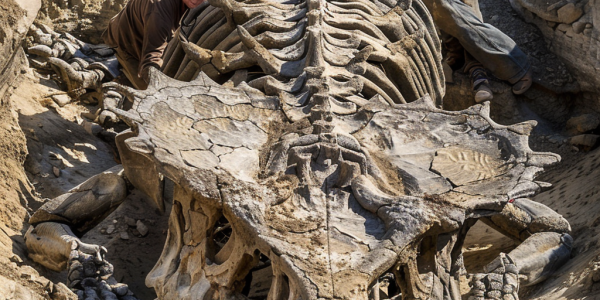Fossils of ‘Sea Phantom’ Pterosaur Unearthed in Australia
Discover the fossils of the ‘sea phantom,’ a unique flying reptile named Haliskia peterseni, found in Queensland, Australia. With a wingspan of 15 feet and specialized features for hunting marine prey, this pterosaur sheds light on the Cretaceous Period 100 million years ago. The study led by Adele Pentland reveals insights into Haliskia’s anatomy, showcasing its adaptations for capturing fish and squid-like cephalopods. This remarkable discovery expands our knowledge of anhanguerians and offers a glimpse into Australia’s prehistoric ecosystem.
Man Discovers 70% Complete Stegosaurus Fossil on Birthday Walk
Discover the incredible story of a 45-year-old man who unearthed a 70 percent-complete stegosaurus fossil on his property, now set to be auctioned at Sotheby’s for $4 to $6 million. This rare find has sparked concerns among paleontologists about the fate of ‘Apex’ and the accessibility of such valuable specimens for research and public viewing.
Family Discovers Rare Juvenile T-Rex Skeleton in North Dakota Badlands
A family hiking in the North Dakota Badlands stumbled upon the rare juvenile skeleton of a Tyrannosaurus rex, believed to be a tibia of a 10-foot-tall, 3,500-pound dinosaur named Teen Rex. The find has garnered attention from scientists and paleontologists worldwide, marking it as a rare and valuable discovery that sheds light on the prehistoric world and the creatures that once roamed the earth.
Florida Diver Discovers Ancient Mastodon Tusk Off Coast
A Florida man diving off the coast of Manasota Key discovered a potentially millions of years old mastodon tusk, highlighting the rarity of such finds in Florida’s waters. Standing at heights of up to 10 feet, mastodons were massive creatures that roamed North and Central America until their extinction around 10,500 years ago. Responsible fossil hunting practices are emphasized to preserve valuable artifacts for scientific study, as the discovery adds to the rich tapestry of prehistoric finds in the region.
Ancient ‘Echidnapus’ Fossil Unearthed in Australia
Australian scientists have discovered the ancient ‘echidnapus’ in opal fields in New South Wales, shedding light on Australia’s ‘age of monotremes’. The newly identified Opalios splendens species, resembling the platypus and echidna, expands the known diversity of prehistoric egg-laying mammals. This groundbreaking find, detailed in the journal Alcheringa, highlights the unique evolutionary history of Australian fauna.
23,000-Year-Old Footprints Unearthed in New Mexico
Archaeologists in New Mexico have unearthed 23,000-year-old footprints, reshaping the narrative of human history in America. This groundbreaking discovery challenges previous beliefs and offers valuable insights into the lives of early inhabitants, shedding light on their interactions with the environment and wildlife.
Fossil Gen 6 Smartwatches on Sale for $79
Fossil is offering its Gen 6 smartwatches at a discounted price of $79, down from $299. Despite exiting the Wear OS market, the company is clearing out inventory with this deal. The Gen 6 smartwatch boasts features like Google Assistant, Snapdragon Wear 4100+ platform, and more, making it a great value at $79.
Enormous ancient sea reptile identified from amateur fossil find
Scientists have identified the largest marine reptile ever, a creature longer than two buses, living 202 million years ago. Fossil hunters found jawbones in Somerset, UK, leading to the discovery of two giant ichthyosaurs. More evidence is needed to confirm the 25m length, as only fragments have been found. The first jawbone was discovered in 2016, with a second found in 2020 by a father and daughter. The team continues to search for more pieces to uncover the full size of the ancient sea reptile.
Groundbreaking Discovery of Ancient Amino Acids in Dinosaur Eggshell Fossils Sparks New Excitement in Paleobiology
Groundbreaking study reveals ancient amino acids in titanosaur eggshell, sparking new potential for understanding ancient life. Dr. Kirsty Penkman expresses elation at the unexpected discovery, opening new avenues for scientific inquiry and offering valuable insights into the preservation of organic material.
Newly Discovered Prehistoric Species Resembles Famous Froggy Celebrity
Paleontologists at the Smithsonian National Museum of Natural History have unearthed a previously unknown prehistoric species, Kermitops gratus, dating back over 270 million years. The tiny fossilized skull of Kermitops, resembling the famous Muppet character Kermit the Frog, offers valuable insights into the evolutionary origins of modern amphibians. This discovery challenges existing research and highlights the need for continued exploration and study of museum collections.










